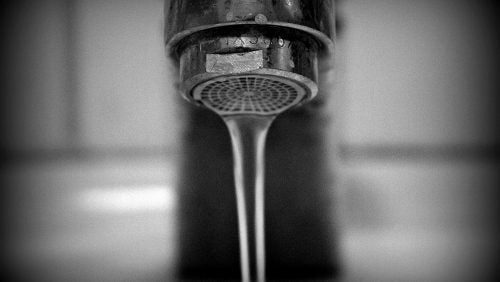Final PFAS Regulations Are Here, and More Are On the Way
April 17, 2024 by John Powers

Water flows from a kitchen faucet.
EPA has been working quickly to regulate PFAS across the United States. The National Primary Drinking Water Regulation for PFAS is now finalized, and more final rules are right around the corner.
Per and polyfluoroalkyl substances (PFAS) are the new hot topic in environmental law, and for good reason.[1]PFAS are a group of synthetic, long-lasting, “forever” chemicals that have been widely used in consumer products since the 1950s.[2] They are utilized, for example, in the manufacturing of textiles and plastics. PFAS degrade incredibly slowly, and have been found in increasing concentrations in water, air, soil, fish and animals around the globe.[3] The long-term health effects of exposure to many PFAS are still unclear, but recent scientific studies have concluded exposure to some types of PFAS is correlated with harmful health effects.[4]
Unsurprisingly, EPA has increasingly sought to regulate PFAS in an effort to reduce human exposure and increase long-term human health benefits. Regulating PFAS has required a multi-pronged approach, however, as the chemicals have been found throughout the environment. Last week EPA finalized the first National Primary Drinking Water Regulation for PFAS pollution utilizing their authority under the Safe Drinking Water Act.[5] The final rule establishes enforceable national drinking water standards called Maximum Contaminant Levels (MCL) for five individual PFAS, and Hazard Index level for combinations of four PFAS.[6] The new rule will reduce the levels of PFAS in drinking water nationwide, based on the best available control technology.[7] Water systems have three years to establish initial monitoring systems, and five years to implement control technology that reduce PFAS to at or below the MCLs.[8] Water systems have generally responded favorably to EPA’s efforts to limit consumers’ PFAS exposure, while voicing concerns about the costs such controls may impose on them and their consumers and emphasizing the need for targeted regulation of PFAS sources.[9]
The safe drinking water regulation, however, is just the first step in EPA’s regulatory agenda for PFAS. EPA’s decision on another rule is right around the corner – the proposed designation of two PFAS chemicals as CERCLA hazardous substances.[10] The Comprehensive Environmental Response, Compensation, and Liability Act (CERCLA) provides the federal government authority to clean up sites releasing hazardous substances into the environment. Under CERCLA, the current and past owners or operators of a facility, as well as parties who arranged for or transported hazardous substance to the impacted site, may be held strictly liable for the cost of clean-up of the hazardous substance.[11] Designating PFAS as hazardous substances under CERCLA would therefore provide sweeping authority to the federal government to reduce PFAS levels throughout the environment.
Water utilities and other potentially responsible parties are concerned about the impact strict and retroactive liability for PFAS contamination may have on them. Would a public water utility, for example, be considered a transporter under CERCLA if they passively received contaminated water from their water sources and subsequently discharged that water to homes and sewer systems? Utilities have called for tailored protections to limit such liability, and the Senate Environmental Works Committee has recently held hearings on the issue.[12]
Those concerns haven’t stopped EPA from pushing forward with PFAS regulations. EPA most recently proposed both to list specific PFAS as hazardous constituents under the Resource Conservation and Recovery Act (RCRA) and to revise RCRA’s definition of “hazardous waste,” to allow RCRA’s corrective action authority to apply to emerging contaminants such as PFAS.[13] The RCRA Corrective Action Program, similar in some respect to CERCLA, requires facilities that “treat, store, and dispose of hazardous waste to investigate and clean up hazardous releases.”[14] The proposed rules would also bring EPA one-step closer to identifying PFAS as “hazardous waste” outright under RCRA, which automatically triggers listings under CERCLA.[15] Unsurprisingly, the concerns from utilities are the same: a boom of CERCLA litigation that would negatively impact both utilities and consumers.[16]
EPA should be concerned about the impact of PFAS on the environment given the high cost of PFAS on the environment and human health. In respect to the finalized National Primary Drinking Water Regulation alone, EPA has estimated the cost of compliance for utilities will be $1.5 billion annually, and the benefits of the rule for human health and the environment are estimated to greatly exceed that. Time will tell if and how EPA and Congress choose to address the issue of cost to water utilities and other potentially responsible parties. Whatever their choice, however, PFAS regulations are here today, and here to stay.
[1] The views expressed herein are those of the author and are not presented as those of the Congressional Research Service or Library of Congress.
[2] Perfluoroalkyl and Polyfluoroaalkyl Substances (PFAS), NIH (Apr. 2, 2024), https://www.niehs.nih.gov/health/topics/agents/pfc
[3] PFAS Explained, EPA (Oct. 25, 2023), https://www.epa.gov/pfas/pfas-explained
[4] Id.
[5] Press Release, EPA, Biden-Harris Administration Finalizes First-Ever National Drinking Water Standard to Protect 100M People from PFAS Pollution (April 10, 2024), https://www.epa.gov/newsreleases/biden-harris-administration-finalizes-first-ever-national-drinking-water-standard.
[6] See EPA, Fact Sheet: PFAS National Primary Drinking Water Regulation (2024).
[7] Id.
[8] Id.
[9] Press Release, Metropolitan Washington Council of Governments, Water utilities in D.C. region respond to U.S. Environmental Protection Agency ruling on PFAS (Apr. 11, 2024), https://www.mwcog.org/newsroom/2024/04/11/water-utilities-in-dc-region-respond-to-us-environmental-protection-agency-ruling-on-pfas-drinking-water-water-quality/.
[10] Proposed Designation of PFOA and PFOS as CERCLA Hazardous Substances, EPA (Oct. 30, 2023), https://www.epa.gov/superfund/proposed-designation-perfluorooctanoic-acid-pfoa-and-perfluorooctanesulfonic-acid-pfos.
[11] Superfund Liability, EPA (May 23, 2023), https://www.epa.gov/enforcement/superfund-liability.
[12] See Water Coalition Testifies Before Senate About Importance of a PFAS CERCLA Exemption for Utilities, NACWA (Mar. 20, 2024), https://www.nacwa.org/news-publications/news-detail/2024/03/20/water-coalition-testifies-before-senate-about-importance-of-a-pfas-cercla-exemption-for-utilities.
[13] Listing of Specific PFAS as Hazardous Constituents, 89 Fed. Reg. 8606 (April 8, 2024). See also, EPA’s Latest PFAS Push Targets Nine Substances Under RCRA, Perkins Coie (Feb. 15, 2024), https://www.perkinscoie.com/en/news-insights/epas-latest-pfas-push-targets-nine-pfas-substances-under-rcra.html.
[14] What is Corrective Action?, EPA (Feb. 1, 2024), https://www.epa.gov/hw/learn-about-corrective-action.
[15] EPA’s Latest PFAS Push Targets Nine Substances Under RCRA, Perkins Coie (Feb. 15, 2024), https://www.perkinscoie.com/en/news-insights/epas-latest-pfas-push-targets-nine-pfas-substances-under-rcra.html.
[16] Metropolitan Water District of Southern California, Comment Letter on Proposed Rule Listing Specific PFAS as Hazardous Constituents (Apr. 8, 2024), https://www.regulations.gov/comment/EPA-HQ-OLEM-2023-0278-0230.

